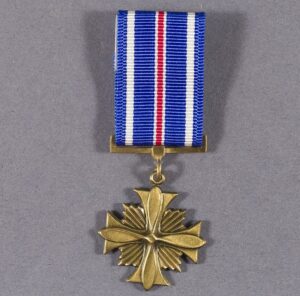Air Heroes of Afghan Evacuation
Receive the Distinguished Flying Cross
By: James G. Fausone, Esq.
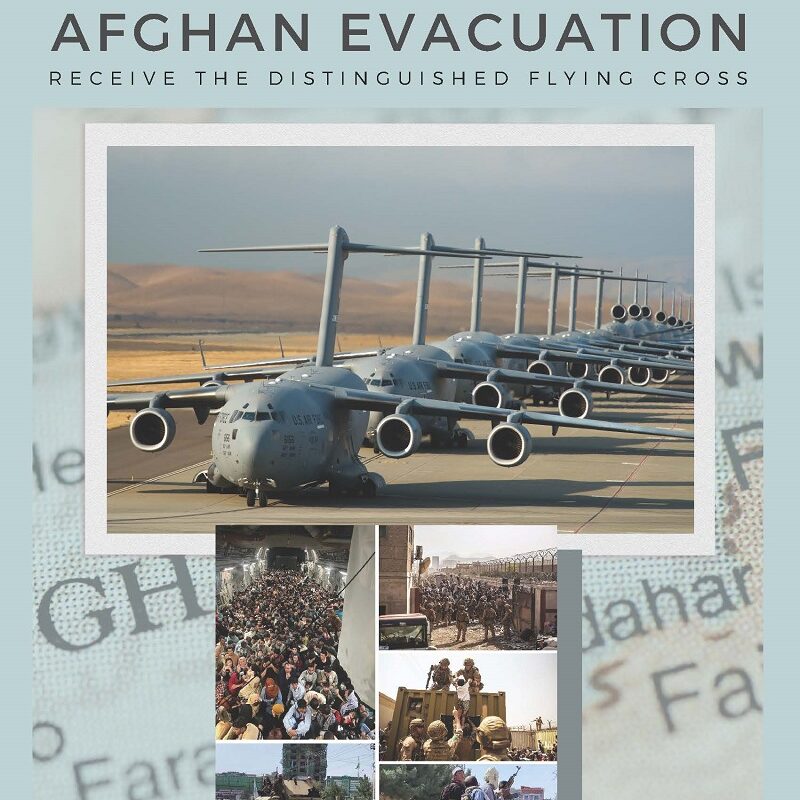
Many would say that nothing heroic took place when the United States pulled out of Afghanistan in 2021. While this is an understandable statement, looking deeper you see individuals and units that performed admirably. The air evacuation that took place in August 2021 was choreographed chaos. The efforts of the men and women assigned the mission to get those needing medical attention and certain allies out of the Country demonstrate courage and bravery under unique circumstances. This was another war that America had grown weary of and the withdrawal turned deadly and chaotic.
A Twenty-Year War
The United States went to war in Afghanistan in response to the terrorist attacks of September 11, 2001. On that day, the extremist group Al-Qaeda, funded by Osama bin Laden (OBL), hijacked four commercial airliners and carried out coordinated suicide attacks, resulting in the deaths of nearly 3,000 people, on the World Trade Center in New York City, the Pentagon in Washington, D.C. and a failed attempt crashing in Shanksville, Pennsylvania. The U.S. government held Al-Qaeda responsible for the attacks, and it was discovered that the group had been given sanctuary by the Taliban, which controlled Afghanistan at the time. The Taliban had provided a safe haven for Al-Qaeda and had refused to hand over OBL to the United States for prosecution.

In response, the U.S. launched a military operation in Afghanistan known as Operation Enduring Freedom on October 7, 2001. The objective was to remove the Taliban from power, dismantle Al-Qaeda, and prevent future terrorist attacks. The U.S. government believed that eliminating the safe haven for Al-Qaeda and disrupting their operations, could reduce the threat of terrorism against the United States and its allies. Over time, the mission in Afghanistan evolved from a focused effort against Al-Qaeda to a broader counterinsurgency campaign aimed at stabilizing the country and supporting the development of a democratic government. This expanded multi-layered mission involved efforts to build Afghan security forces, promote governance and development, and protect the Afghan population from Taliban resurgence. The war in Afghanistan lasted for more than 20 years, with the U.S. gradually reducing its military presence over time. The conflict became complex and faced numerous challenges, including insurgency, corruption, and a lack of stable governance in Afghanistan.
The United States military officially completed its withdrawal from Afghanistan on August 31, 2021. The decision to withdraw the troops was announced by then-President Donald Trump in February 2020, and the process of withdrawing troops began under his administration. The subsequent administration of President Joe Biden modified the plan and completed the withdrawal.
The End is in Site - Operation Allies Refuge
As the date for the final military pull out of Afghanistan approached, plans were made for the air evacuation of those requiring medical evac and Afghan citizens, particularly those who had worked with or supported the United States and its allies, as well as individuals at risk due to the changing security situation in Afghanistan. This evacuation took place during the final stages of the U.S. military withdrawal from Afghanistan in August 2021.
As the Taliban rapidly gained military and operational control over Afghan territory, there was a heightened sense of urgency to evacuate vulnerable individuals. The air evacuation efforts primarily centered around the Hamid Karzai International Airport in Kabul, which was under the control of U.S. and coalition forces. Thousands of U.S. military personnel were involved in the evacuation with an emphasis on securing the airport.
The evacuation process involved a combination of military flights, civilian charters, and cooperation with international partners. The U.S. military and its allies worked to evacuate as many people as possible, operating under intense time pressure due to the rapid Taliban advance. Initially, the evacuation process faced significant challenges, including chaotic scenes at the airport, overcrowding, and security threats. However, efforts were made to streamline the process and increase efficiency. Over time, the situation at the airport improved, and evacuation operations became more organized. The evacuation continued for several weeks, with military aircraft shuttling people out of Kabul and transporting them to third-country locations for further processing and resettlement. Countries around the world, including the United States, United Kingdom, Germany, Canada, and others, played a role in receiving and resettling Afghan evacuees. It's important to note that despite the evacuation efforts, not everyone who wanted to leave Afghanistan was able to do so. The challenging security situation, logistical constraints, and time limitations posed significant obstacles. Overall, the air evacuation of Afghans aimed to provide a means of escape for individuals at high risk and to try to honor the commitments made to those who had supported U.S. and allied forces in Afghanistan.
The military mounted Operation Allies Refuge in August 2021 to facilitate the evacuation. Under Operation Allies Refuge, eligible Afghan individuals and their immediate families were evacuated from Afghanistan and transported to temporary safe locations for processing and screening. The program prioritized individuals who faced significant threats due to their affiliation with the U.S. government, military, or international organizations.
The operation involved coordination between various U.S. government agencies, including the Department of State, Department of Defense, and Department of Homeland Security. These agencies worked together to identify eligible individuals, process their documentation, conduct security screenings, and arrange for their transportation and resettlement. Once evacuated, the individuals were taken to designated transit centers or military bases in third countries for further processing and screening. These locations included countries in the Middle East, Europe, and other regions. While in these temporary safe locations, Afghan evacuees underwent medical screenings, security vetting, and administrative processing. The goal was to ensure that individuals being resettled met the necessary requirements for entry into the receiving countries. The United States, along with international partners, worked to find permanent resettlement options for the evacuated Afghans. This included efforts to identify and secure housing, healthcare, and other essential services for those awaiting their final destination. The program aimed to provide a lifeline to vulnerable individuals and offer them a chance to build new lives in safe environments, away from the conflict and potential threats in their home country.
The C-17 Work Horse
The C-17 Globemaster III is a large military transport aircraft operated by the United States Air Force and other allied countries. It has the capability to rapidly transport cargo, personnel, or patients over long distances and in challenging conditions. The aircraft's spacious interior and versatility make it well-suited for medical evacuation missions.
During a C-17 medical evacuation flight, the aircraft is outfitted with medical equipment and personnel to provide critical care to patients in flight. This often includes doctors, nurses, and medics who are trained in providing in-flight medical treatment.
The interior of the C-17 can be configured to accommodate medical stretchers or pallets with medical equipment, ensuring patients are secure and receive the necessary care during the flight. The aircraft is equipped with life support systems, including oxygen supplies, monitors, and other medical equipment, to stabilize and monitor the condition of patients during transport.
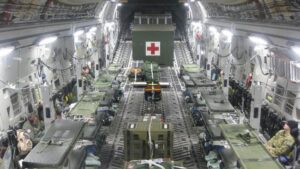
C-17 medevac flights are often utilized in emergency situations, such as natural disasters, humanitarian crises, or military operations, where timely medical evacuation is crucial for saving lives. These flights can transport patients from remote or inaccessible locations to hospitals or medical facilities equipped to provide the required level of care.
The C-17's long-range capabilities and ability to operate in austere environments make it an important asset for medical evacuation missions, as it can reach areas that may not be accessible by other means of transportation. Additionally, the aircraft's ability to land on short runways and unpaved surfaces further enhances its utility in challenging environments.
Overall, C-17 medical evacuation flights play a vital role in swiftly and safely evacuating injured or critically ill patients from areas where they may not have immediate access to adequate medical care, ensuring they receive the necessary treatment and improving their chances of recovery.
A Week of Chaos
After the fall of Kabul to the Taliban on August 15, 2021, Hamid Karzai International Airport was the only air transport way out of Afghanistan. As everyone in Afghanistan knew, the Americans were pulling out in late August 2021, and the crowds at the Karzai airport swelled. That congregation of people, those who wanted out of the Country, those that America promised to help, and those who thought America would get them to a safe haven, grew so large the security concern was obvious. It was a concern for the Americans and an obvious target for mischief and destruction. The American military was securing the gates to the airport, now known as Kabul International Airport, checking for passports, proper documents, head counts, and weapons. This security effort was a 24-hour duty by the young Marines on the station.
Two air evacuation missions in particular are memorable resulting in the awarding of the Distinguished Flying Cross (DFC) to the mission crews. The two missions were days apart and for different purposes and destinations. Reach 651 was on August 22nd and Moose 98 was on August 26, 2021. One was planned chaos, and the other was just chaos.
August 22nd - Reach 651
Reach 651 was a C-17 flight that evacuated Afghan citizens from Kabul on Aug. 22, 2021, just a few days after the Taliban seized control of the capital city. Amid concerns about suicide bombs and hijacking, the crew searched every passenger before boarding, then had to deal with two crises after takeoff—a suddenly ill passenger and a “potentially dangerous situation.” The crew of the Air Force C-17 transport found themselves in such circumstances while in the air over Al Udeid Air Base, Qatar. Reach 651 was among more than a hundred other C-17 flights charged with moving the evacuees, often by squeezing 450 or more people on each flight. This herd of Afghan refugees included dozens of parentless children. Each person was seated on the floor of the cargo plane in rows, sitting shoulder to shoulder. As anyone who has ever flown on a C-17, it does not take long to curse the designer who focused on flexible space rather than comfort. There is only one small toilet and no air conditioning. It was impossible for the refugees to use the facility and relieving oneself on the cargo floor was a necessity.
The Reach 651 flight, like many others, also faced massive cultural and linguistic challenges moving that many people onto their first airplane flight. Reach’s solo interpreter was a woman who was not taken seriously by the refugees and struggled with her English. This was a recipe for a disaster and one that had to be avoided.
Breaking Rules to Get the Job Done
During the Reach 651 mission, Senior Airman Kimberly Heiser and Major Drew Dela Cruz were faced with circumstances that they could not train for but must resolve to save the flight and finish the mission. The Air Force ethos takes over in those circumstances including “Service Before Self.”
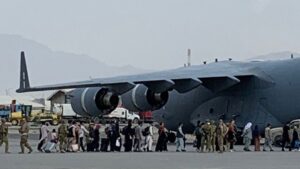
The conditions and the cultural differences came to a boiling point when Reach 651 arrived in the airspace over Al Udeid Air Base, Qatar. There were so many aircraft landing at the air base that it caused a traffic jam in the sky, with planes like Reach 651 having to stay in the air for as long as possible. The backup of planes was not only in the sky but also on the tarmac. As a result of the long delay, Reach 651 was running out of aviation fuel. As Major Dela Cruz was worrying about the fuel problem another crisis was occurring in the human cargo hold. A 16-year-old mother began convulsing and soon fell unconscious.
Maj. Dela Cruz, a 2012 graduate of the US Air Force Academy, was an experienced pilot and a cool customer. He had flown KC-135 air tankers and that knowledge helped as Reach 651 was thirsty and facing an emergency. Dela Cruz was credited with poise, sound decisions, and command authority about Reach 651 constituting extraordinary achievement in aerial flight. But it was the rest of the developing crisis that caused the need for such poise.
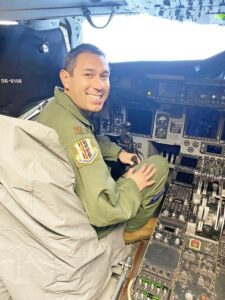
As a result of the packed cargo floor, it was impossible to help the convulsing 16-year-old woman. As demanded by the culture, Senior Airman Kimberly Heiser was called into action to help the young girl. This was not a medical flight. Heiser had to climb over refugees to reach the girl. It was clear that insufficient space could be made to lay her flat and work with her. Maj. Dela Cruz, breaking protocol, gave Heiser permission to bring the woman up to the cockpit area so space would be available to attempt to stabilize the woman. As the airmen carried the young girl away male passengers were getting agitated because of the cultural and language barriers. Heiser was the sole female member of the Reach 651 crew and as such had to take the lead. Heiser said, "I think it would have gone a lot differently if one of the men were forced to administer aid." The young woman certainly had heat stress as did many other refugees.
This medical incident, and the stressful trip, led to two Afghan men feeling compelled to take action. They "aggressively forced their way to the front of the cargo compartment and attempted to gain entry into the flight deck," it was reported. One of the Air Force loadmasters pulled one man away while an Air Force Phoenix Raven (a highly trained security force member) stopped the other using nonlethal force. Heiser is quoted as saying: "The decision to not use lethal force to protect the cockpit demonstrated an extraordinary restraint by the aircrew, as they were briefed to use all means necessary to prevent Afghans from gaining entry to the flight deck. This action protected the lives of the aircrew, the safety of the aircraft, and the lives of all 450 passengers floor-loaded on the aircraft."
As tensions were boiling over in the cargo area, inside the cockpit one of the pilots, 1st Lt. Ryan Corvin, barricaded the door, and one of the aircrew stood ready with a service pistol in case of a breach. At the same time, Heiser had to hold down and help the young woman and ignore activity downstairs in the cargo area. Dela Cruz facing all this activity declared a medical emergency and took the C-17 down for a landing. However, things on the airfield were so crowded, that air traffic control gave multiple unsafe taxiing instructions until the crew found a safe route which allowed for the medics to board to remove the young woman for treatment. Heiser regrets never learning the fate of the young mother. Finally, when on the ground and stopped, the crew was able to get water to the refugees and their tempers cooled, but the dry desert air did not.
Reach 651 Crew Receiving DFC for actions on 8/22/2021
- Maj. Alexander A. Arcidiacono
- Maj. Drew P. Dela Cruz
- 1st Lt. Ryan S. Corvin
- Staff Sgt. Brandon S. Jensen
- Staff Sgt. E-Quantay L. Mason
- Senior Airman Kimberly S. Heiser
- Senior Airman Matthew S. Williams
- Airman 1st Class Jeremy Eda
August 25th Bombing at Kabul Airport
On August 25, 2021, at Abbey Gate, one of the gates into the airport, a suicide bomber detonated an explosive belt. After the explosion, gunfire erupted and all gates to the airport were closed. The explosion occurred by a canal where US forces were checking evacuees' passports, visas, and other documentation before allowing them inside the airport.
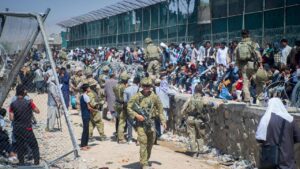
The attack was carried out by Islamic State IS-KP, which claimed responsibility and named the bomber. The Taliban had fought against IS–Khorasan Province and were helping the US forces to maintain security at the airport. At least 182 people were killed during the attack, including 169 Afghan civilians, and 13 US service members supporting the evacuation operation. Two of the killed civilians were British dual-nationals and one was the child of a British national.
The 13 KIA, 11 Marines, one Navy corpsman, and one Army soldier were “killed as the result of an enemy attack while supporting non-combatant evacuation operations,” according to DOD. These 13 received the Congressional Gold Medal in November 2021. Rep. Lisa McClain, R-Mich., introduced the bipartisan legislation to honor the fallen troops on August 31, just hours after the last American military troops left Afghanistan.
“The American service members went above and beyond the call of duty to protect citizens of the United States and our allies to ensure they are brought to safety in an extremely dangerous situation as the Taliban regained control over Afghanistan,” the bill reads. “The American service members exemplified extreme bravery and valor against armed enemy combatants [and] …members dedicated their lives and their heroism deserves great honor.” The Congressional Gold Medal dates back to the American Revolution and serves as Congress’ “highest expression of national appreciation for distinguished achievements and contributions,” according to a House description of the award. It has been awarded 173 times to individuals or groups of people.
The 11 Marines are –
- Staff Sgt. Darin T. Hoover, 31, of Salt Lake City, Utah
- Sgt. Johanny Rosariopichardo, 25, of Lawrence, Massachusetts
- Sgt. Nicole L. Gee, 23, of Sacramento, California
- Cpl. Hunter Lopez, 22, of Indio, California
- Cpl. Daegan W. Page, 23, of Omaha, Nebraska
- Cpl. Humberto A. Sanchez, 22, of Logansport, Indiana
- Lance Cpl. David L. Espinoza, 20, of Rio Bravo, Texas
- Lance Cpl. Jared M. Schmitz, 20, of St. Charles, Missouri
- Lance Cpl. Rylee J. McCollum, 20, of Jackson, Wyoming
- Lance Cpl. Dylan R. Merola, 20, of Ranchero Cucamonga, California
- Lance Cpl. Kareem M. Nikoui, 20, of Norco, California;
Also killed were -
- Navy Corpsman Maxton W. Soviak, 22, of Berlin Heights, Ohio, and
- Army Staff Sgt. Ryan C. Knauss, 23, of Corryton, Tennessee.
In response to the Abbey Gate bombing, the United States launched drone attacks on a vehicle with the alleged bomber on August 29. However, it was later determined the intel was faulty, and an innocent aid worker was killed. About two years later, the Taliban claimed to have captured and killed the Abbey Gate bomber.
August 26th - Moose 98
The Kabul evacuation operation had numerous flights named Moose numbered from 84 to 98. One challenge was that these heavy flights could not refuel at the Kabul airport so these C-17s were in need of air refueling. Just one more complication in a chaotic withdrawal. Over 120,000 people were evacuated from Kabul during the month of August 2021. The Air Force Times reported “The effort, which at times was frantic, ad hoc and coolly efficient, drained the Air Force of a large percentage of its heavy-lift fleet. In all, more than 250 U.S. Air Force mobility aircraft contributed to the airlift, including C-17 Globemaster IIIs, C-5M Super Galaxies, C-130 Hercules, and all three air refueling aircraft (KC-135 Stratotankers, KC-10 Extenders, and KC-46 Pegasus). Roughly half of the Air Force’s fleet of 222 C-17s were committed to this operation.”
Moose 98, a C-17 flight, had a medivac mission on August 26, the day a suicide bombing killed 13 U.S. service members and injured more than a dozen others. It was the first flight into the airport after the suicide bomb explosion. Moose 98 was carrying a critical care air transport team (CCATT) that helped evacuate the most severely wounded personnel to receive immediate care, including U.S. service members, Afghan civilians, and children. The team had to respond rapidly after loading severely wounded patients, as more wounded individuals kept coming without warning. By the time the mission was done, Moose 98 had participated in the largest aeromedical evacuation airlift from Kabul Coalition Hospital. Every patient on the flight arrived safely at Landstuhl Regional Medical Center, Germany.
“Although I was told what to expect, it was very shocking to see very young Marines, Sailors, and Soldiers walk on the plane with traumatic injuries,” said Maj. Katelyn Dunahoe, a flight nurse with Moose 98, in a statement. “But my crew responded fast and effectively. The bravery and selflessness they all displayed is indescribable.”
Just a National Guard Nurse Doing Her Job
Doctors and pilots get all the glory. Just ask any military nurse or medic. It is easy to overlook the Distinguished Flying Cross when given to a group for their team efforts. But the meaning to that one person, and their community, cannot be overstated. In the Moose 98 crew, there was an Air National Guard nurse, Major Katie Lunning.
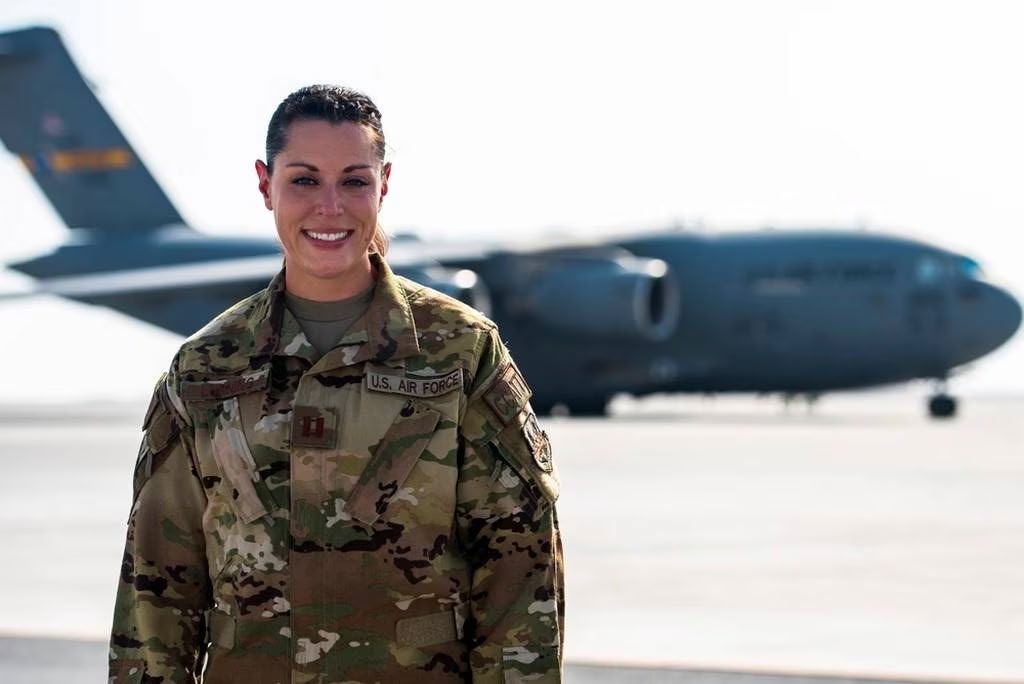
For only the second time in history, a Registered Nurse has been awarded a Distinguished Flying Cross (DFC). She is also the first Air National Guard nurse to ever receive the award, according to the National Guard Association of the United States. She was a Guard nurse deployed for a six-month tour at a medical unit at Al Udeid, Qatar starting in July 2021. A month later, she was part of Moose 98 and part of history.
The first registered nurse to receive the DFC was Aleda E. Lutz. U.S. Army Nurse Lutz flew over 800 hours during 196 missions and evacuated over 3,500 men during World War II. That was at the dawn of aeromedical flights. On November 1, 1944, the C-47 hospital plane evacuating wounded soldiers from the battlefront near Lyons, Italy, crashed killing all on board. On December 28, 1944, she was posthumously awarded the Distinguished Flying Cross. She was the first woman to be awarded the medal in war. She has been inducted into the Michigan Military and Veterans Hall of Honor and a Veterans Affairs Medical Center in Saginaw, Michigan is named after Lt. Lutz.
US Army Lt. Elise Ott, RN of New York is considered America’s first flight nurse for her pioneering seven-day around-the-world medical flight in 1943. Her 11,000-mile odyssey from Karachi, Pakistan to Washington, DC safely transported five patients.
Lunning began her journey into nursing by first entering the healthcare field as a combat medic with the Minnesota Army National Guard directly out of high school. Finding her passion, she then decided to pursue nursing through the Minnesota Air National Guard and received a direct commission as an officer. She joined the Minnesota VA while still a student nurse and graduated from Bethel University in St. Paul, MN with her BSN. Once graduated, she gained employment in the ICU as an RN in the VA healthcare system. She has been a member of the Minnesota Air National Guard air transport, 133rd Airlift Wing.
On the regular medical evacuation missions into Karzai airport, Lunning would push a stretcher from the runway to the airport gate and down three blocks to reach a tiny international hospital for evacuating critical condition patients. As the throng of Afghans pressed into the streets, Lunning was armed with only a Beretta M9 pistol and never felt she would draw it. The evac medical team generally had two doctors, two respiratory specialists, and two nurses. Typically, the flights were 3.5 hours from Kabul to Qatar taking care of a few critical care patients.
The concept of a typical mission exploded on August 26, 2021, when the suicide bomb detonated. As she stated in a VA press release: “We were pulling them out as they are getting injured,” said Lunning. “August 26th, when the suicide bomber exploded at Abbey Gate, we were the first team in. It was the largest medical evacuation out of that coalition hospital ever and very dangerous on the ground. We had to leave the airplane to go get our patients as well.” “We took injured Marines and Afghan civilians who really weren’t flight-worthy, but there was no choice. We just had to get them out of there. A lot of medical events occurred on the airplane, but we ended up being able to safely deliver everybody to Landstuhl, Germany, for further medical care.”
Lunning had been an RN for nine years when facing the toughest assignment of her life. “At that moment, I was really just focusing on the job,” she said. “We came up with a mantra. We would say, ‘We can’t control what’s happening on the ground, and what we can control is our jobs.’ We focused very much on getting people home. We all have kids right around the same age that we wanted to get home to.” “We just focused on getting everybody home to their people because everybody’s going to have a why, right? We talked about that and how it was our role to get them back to their reason for being there.” Moose 98 aeromedical evacuated 22 patients in less than 15 hours including six critical and 16 non-critical care patients. All arrived alive.
After the mission, Lunning went back to the VA as an ICU nurse manager at Central Iowa VA. Her community of combat medics, RNs, ICU nurses, VA employees, Air National Guard members, family members, and friends will always be proud of her accomplishments for the Country and what she proved about her communities. She was selected as the Military Times’ 2023 Airman of the Year and continues to inspire many. The effort was that of a team, but that makes it no less noteworthy.
Moose 98 Crew Received the DFC for actions on 8/25/2021
- Lt. Col. Raul R. Montiague
- Lt. Col. William A. Street
- Maj. Katelyn E. Dunahoe
- Maj. Katie B. Lunning
- Maj. Pete N. Traylor
- Maj. Dominick A. Vitale
- Capt. Cody M. Apfel
- Capt. Jedd E. Dillman
- Capt. David L. Stuppy
- Capt. Spencer D. Yacos
- Master Sgt. Matthew A. Newman
- Tech. Sgt. Matthew D. Keefer
- Tech Sgt. Michael A. Raucci
- Staff Sgt. Idaliz Alicea
- Staff Sgt. Katherine Rosa Orellana
- Staff Sgt. Courtney Smith
- Senior Airman Mario Hernandez
- Senior Airman Deniece A. Lobban
- Senior Airman Alexis C. Sanchez
These Crews Earned the DFC
The Distinguished Flying Cross is the nation's fourth-highest award for heroism. The medal was established on July 2, 1926, and is currently awarded to any persons who, after April 6, 1917, distinguish themselves by single acts of heroism or extraordinary achievement while participating in aerial flight. The list of recipients of the DFC reads like a "Who's Who" of Astronauts, Air Force, Army, Marine generals, and Navy flag officers. Numerous recipients of the DFC earned greater fame in other occupations; such as acting, business, and even politics.
The Moose 98 and Reach 651 crews were awarded the DFC for aerial flight extraordinary achievement. Only those who experienced the chaos of the evacuation of Afghanistan and Kabul airport can fully appreciate the stress and challenges of the air evacuations. But everyone can appreciate the extraordinary service and success of these aircrews.
About the Author
Jim Fausone is a partner with Legal Help For Veterans, PLLC, with over twenty years of experience helping veterans apply for service-connected disability benefits and starting their claims, appealing VA decisions, and filing claims for an increased disability rating so veterans can receive a higher level of benefits.
If you were denied service connection or benefits for any service-connected disease, our firm can help. We can also put you and your family in touch with other critical resources to ensure you receive the treatment that you deserve.
Give us a call at (800) 693-4800 or visit us online at www.LegalHelpForVeterans.com
About the Author
Jim Fausone is a partner with Legal Help For Veterans, PLLC, with over twenty years of experience helping veterans apply for service-connected disability benefits and starting their claims, appealing VA decisions, and filing claims for an increased disability rating so veterans can receive a higher level of benefits.
If you were denied service connection or benefits for any service-connected disease, our firm can help. We can also put you and your family in touch with other critical resources to ensure you receive the treatment you deserve.
Give us a call at (800) 693-4800 or visit us online at www.LegalHelpForVeterans.com.
This electronic book is available for free download and printing from www.homeofheroes.com. You may print and distribute in quantity for all non-profit, and educational purposes.
Copyright © 2018 by Legal Help for Veterans, PLLC
ALL RIGHTS RESERVED


